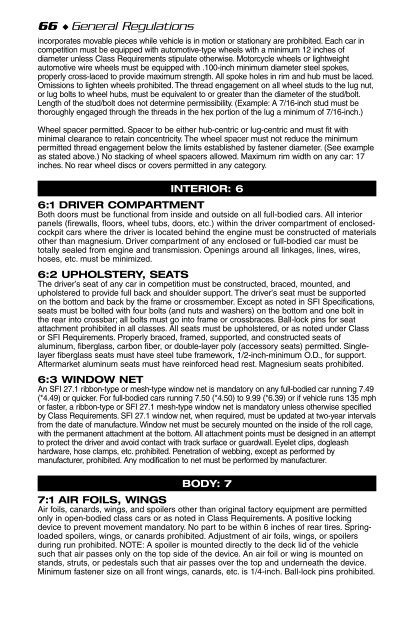2012 NHRA Hot Rod Heritage Racing Series Rules Supplement
2012 NHRA Hot Rod Heritage Racing Series Rules Supplement
2012 NHRA Hot Rod Heritage Racing Series Rules Supplement
You also want an ePaper? Increase the reach of your titles
YUMPU automatically turns print PDFs into web optimized ePapers that Google loves.
66 ◆ General Regulations<br />
incorporates movable pieces while vehicle is in motion or stationary are prohibited. Each car in<br />
competition must be equipped with automotive-type wheels with a minimum 12 inches of<br />
diameter unless Class Requirements stipulate otherwise. Motorcycle wheels or lightweight<br />
automotive wire wheels must be equipped with .100-inch minimum diameter steel spokes,<br />
properly cross-laced to provide maximum strength. All spoke holes in rim and hub must be laced.<br />
Omissions to lighten wheels prohibited. The thread engagement on all wheel studs to the lug nut,<br />
or lug bolts to wheel hubs, must be equivalent to or greater than the diameter of the stud/bolt.<br />
Length of the stud/bolt does not determine permissibility. (Example: A 7/16-inch stud must be<br />
thoroughly engaged through the threads in the hex portion of the lug a minimum of 7/16-inch.)<br />
Wheel spacer permitted. Spacer to be either hub-centric or lug-centric and must fit with<br />
minimal clearance to retain concentricity. The wheel spacer must not reduce the minimum<br />
permitted thread engagement below the limits established by fastener diameter. (See example<br />
as stated above.) No stacking of wheel spacers allowed. Maximum rim width on any car: 17<br />
inches. No rear wheel discs or covers permitted in any category.<br />
INTERIOR: 6<br />
6:1 DRIVER COMPARTMENT<br />
Both doors must be functional from inside and outside on all full-bodied cars. All interior<br />
panels (firewalls, floors, wheel tubs, doors, etc.) within the driver compartment of enclosedcockpit<br />
cars where the driver is located behind the engine must be constructed of materials<br />
other than magnesium. Driver compartment of any enclosed or full-bodied car must be<br />
totally sealed from engine and transmission. Openings around all linkages, lines, wires,<br />
hoses, etc. must be minimized.<br />
6:2 UPHOLSTERY, SEATS<br />
The driver’s seat of any car in competition must be constructed, braced, mounted, and<br />
upholstered to provide full back and shoulder support. The driver’s seat must be supported<br />
on the bottom and back by the frame or crossmember. Except as noted in SFI Specifications,<br />
seats must be bolted with four bolts (and nuts and washers) on the bottom and one bolt in<br />
the rear into crossbar; all bolts must go into frame or crossbraces. Ball-lock pins for seat<br />
attachment prohibited in all classes. All seats must be upholstered, or as noted under Class<br />
or SFI Requirements. Properly braced, framed, supported, and constructed seats of<br />
aluminum, fiberglass, carbon fiber, or double-layer poly (accessory seats) permitted. Singlelayer<br />
fiberglass seats must have steel tube framework, 1/2-inch-minimum O.D., for support.<br />
Aftermarket aluminum seats must have reinforced head rest. Magnesium seats prohibited.<br />
6:3 WINDOW NET<br />
An SFI 27.1 ribbon-type or mesh-type window net is mandatory on any full-bodied car running 7.49<br />
(*4.49) or quicker. For full-bodied cars running 7.50 (*4.50) to 9.99 (*6.39) or if vehicle runs 135 mph<br />
or faster, a ribbon-type or SFI 27.1 mesh-type window net is mandatory unless otherwise specified<br />
by Class Requirements. SFI 27.1 window net, when required, must be updated at two-year intervals<br />
from the date of manufacture. Window net must be securely mounted on the inside of the roll cage,<br />
with the permanent attachment at the bottom. All attachment points must be designed in an attempt<br />
to protect the driver and avoid contact with track surface or guardwall. Eyelet clips, dogleash<br />
hardware, hose clamps, etc. prohibited. Penetration of webbing, except as performed by<br />
manufacturer, prohibited. Any modification to net must be performed by manufacturer.<br />
BODY: 7<br />
7:1 AIR FOILS, WINGS<br />
Air foils, canards, wings, and spoilers other than original factory equipment are permitted<br />
only in open-bodied class cars or as noted in Class Requirements. A positive locking<br />
device to prevent movement mandatory. No part to be within 6 inches of rear tires. Springloaded<br />
spoilers, wings, or canards prohibited. Adjustment of air foils, wings, or spoilers<br />
during run prohibited. NOTE: A spoiler is mounted directly to the deck lid of the vehicle<br />
such that air passes only on the top side of the device. An air foil or wing is mounted on<br />
stands, struts, or pedestals such that air passes over the top and underneath the device.<br />
Minimum fastener size on all front wings, canards, etc. is 1/4-inch. Ball-lock pins prohibited.


